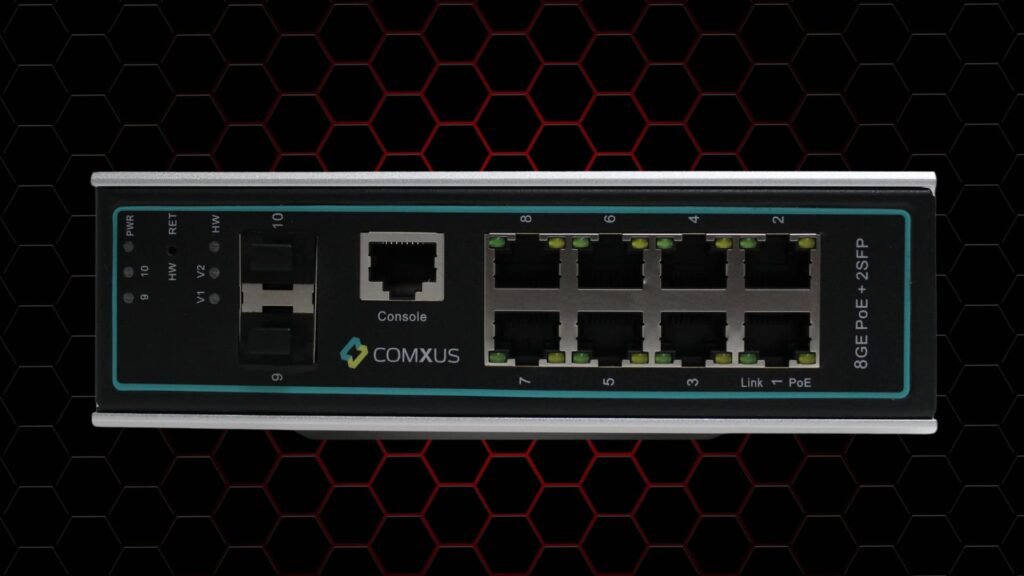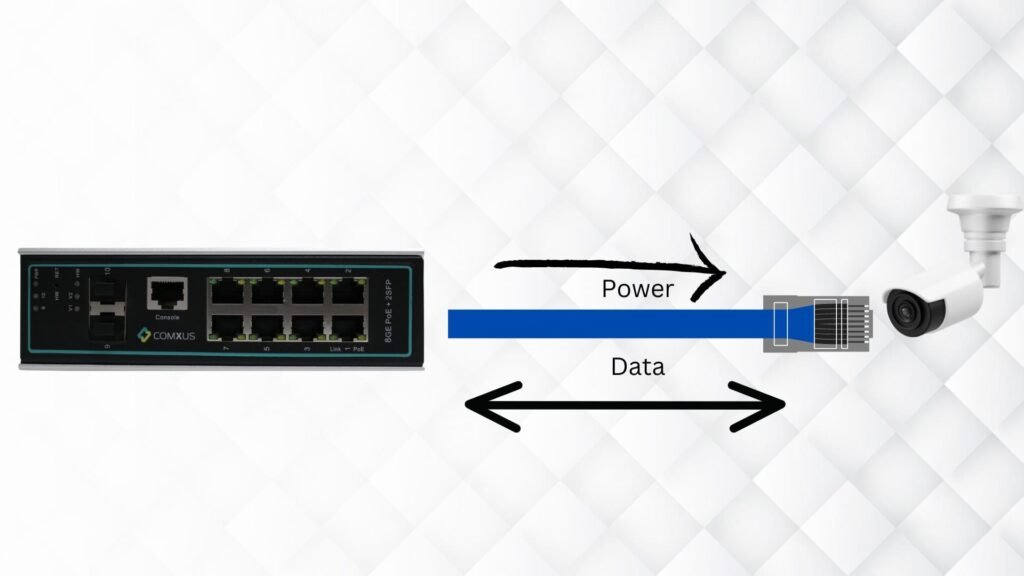In the modern tech edge, PoE switches have become primary components for organizations.
As the demand reliable network infrastructure grows, PoE switches are seen as necessary tools that simplify networking while also powering devices.
But what exactly is a PoE switch, and how does it work? This article will break it down, exploring its definition, functionality, types, and the numerous benefits it offers.

What Is A PoE Switch?
A PoE switch is a network switch that provides both power and data transmission over a single Ethernet cable to connected devices.
This allows network devices like IP cameras, wireless access points, and VoIP phones to receive power without needing separate electrical wiring.
So, it is not only a cost-effective device but also efficient solution for modern network setups.
The primary feature that sets Power of ethernet switches apart from standard network switches is their ability to supply power.

This eliminates the need for additional power outlets near the device locations, reducing cable clutter and installation complexity.
PoE switches are particularly useful in areas where installing separate electrical outlets is impractical. Also, it is helpful when power access may be limited.
What Does Power over Ethernet (PoE) Mean?
Power over Ethernet (PoE) is a technology that enables network cables to carry electrical power along with data.
It allows devices to function without requiring a dedicated power source or electrical wiring.
Initially, Peo switches were generally developed for IP phones and surveillance cameras. However, now these devices have also expanded to support a wide range of devices. Some of the examples are access points, IoT devices, and lighting systems.
In simple terms, PoE allows you to power devices like cameras, Wi-Fi routers, and sensors directly through the Ethernet cable that also provides data connectivity.
This convergence of power and data streamlines network installations, lowers costs, and offers increased flexibility.
There are three main standards for PoE, each providing a different level of power:
- PoE (802.3af): Supplies up to 15.4 watts per port.
- PoE+ (802.3at): Provides up to 30 watts per port.
- PoE++ (802.3bt): Delivers up to 60 or 100 watts, ideal for power-hungry devices like PTZ cameras or LED lighting.
How Does an Ethernet PoE Switch Work?
An PoE switch works by injecting power into the Ethernet cable, which then transmits both power and data to connected devices.
This process relies on the use of twisted pair cabling, commonly found in Cat5e, Cat6, or higher-grade Ethernet cables, capable of carrying both electrical power and data signals simultaneously.
Here’s a breakdown of how it operates:
Detection:
The switch first detects whether a connected device is PoE-compatible. This prevents non-PoE devices from being damaged by excessive power.
Classification:
Once a PoE-compatible device is identified, the switch determines the amount of power required. This ensures the device receives the appropriate power level, based on its power class.
Power Delivery:
After classification, the switch sends the required amount of power through the Ethernet cable while also transmitting data. The power is delivered using unused wire pairs in the Ethernet cable or through the data wires in newer standards.
Monitoring:
The switch continuously monitors the power supply, adjusting if necessary and shutting off power if a device disconnects.
What are the Types of PoE Switch?
PoE switches come in different types based on their port capacity and the amount of power they can deliver.
Depending on the size of your network and the power demands of connected devices, you can choose the right PoE switch type for your needs.
Unmanaged PoE Switches:
These are simple plug-and-play switches that require no configuration. They automatically detect PoE devices and provide power without the need for manual setup.
Unmanaged switches are perfect for smaller networks or businesses that require basic network functionality without complex management.
Managed PoE Switches:
These switches offer advanced network control and configuration options. Network administrators can monitor traffic, adjust power delivery, set up VLANs (Virtual Local Area Networks), and more.
Managed switches are ideal for larger enterprises or organizations with complex networking requirements. Talking about the ports, Comxus industrial-grade PoE switches comes with various models. which has different number of ports like- 8 port industrial-grade poe Switch, 16 port industrial-grade switch etc.
PoE+ Switches:
PoE+ switches conform to the 802.3at standard, providing up to 30 watts of power per port.
They are designed for devices that require more power, such as PTZ (Pan-Tilt-Zoom) cameras and access points.
Industrial PoE Switches:
Built for harsh environments, industrial PoE switches can withstand extreme temperatures, dust, and vibrations.
They are commonly used in industries like manufacturing, oil & gas, and transportation, where network devices are deployed in challenging outdoor or industrial conditions.
Rackmount vs. Desktop PoE Switches:
The size and form factor also differentiate PoE switches. Rackmount switches are typically used in large data centers or server rooms, while desktop switches are more compact and suited for small to medium-sized businesses.
Benefits of Using Ethernet PoE Switches
There are several benefits to incorporating PoE switches into your network infrastructure. These benefits contribute to the widespread adoption of PoE technology across various industries.
Cost Efficiency:
One of the most significant advantages of PoE switches is cost savings. By eliminating the need for additional power outlets and electrical wiring, you can significantly reduce installation costs.
PoE switches also allow for centralized power management, which can lead to lower operational expenses.
Flexibility:
With PoE, network devices like cameras, access points, and phones can be placed virtually anywhere, without the constraints of power outlet availability.
This flexibility is especially beneficial for outdoor cameras, remote offices, and areas with limited electrical infrastructure.
Simplified Installation:
PoE simplifies the process of installing devices since there is no need to run separate power lines.
A single Ethernet cable is sufficient for both data and power, making the installation process quicker and more straightforward.
Scalability:
As businesses grow, so do their network requirements. PoE switches are highly scalable, allowing new devices to be added without the need for new power lines.
Expanding your network becomes a simple plug-and-play process, making it easy to scale up as needed.
Centralized Power Management:
Since power is supplied from a central PoE switch, managing and monitoring power usage becomes easier.
This centralized management allows IT administrators to optimize power distribution, detect faults, and shut down or reboot devices remotely, which is particularly useful for network troubleshooting.
Enhanced Safety:
PoE switches are designed with safety in mind. They only supply power when connected to compatible devices, which means there’s no risk of overloading or damaging non-PoE equipment.
The power supply is regulated, ensuring that the device receives the correct voltage, which reduces the risk of short circuits or electrical damage.
Environmental Sustainability:
By using PoE, businesses can reduce their environmental impact. Centralized power management reduces energy waste, and the ability to monitor power usage can further drive energy efficiency.
Additionally, PoE switches eliminate the need for individual power supplies, reducing material waste.
In conclusion, PoE switches are revolutionizing the way we think about powering and connecting network devices.
They offer unparalleled flexibility, cost savings, and scalability, making them indispensable in today’s digital-first business environments.
As networking demands continue to grow, adopting PoE switches can help businesses future-proof their infrastructure while maintaining efficiency and reliability.
